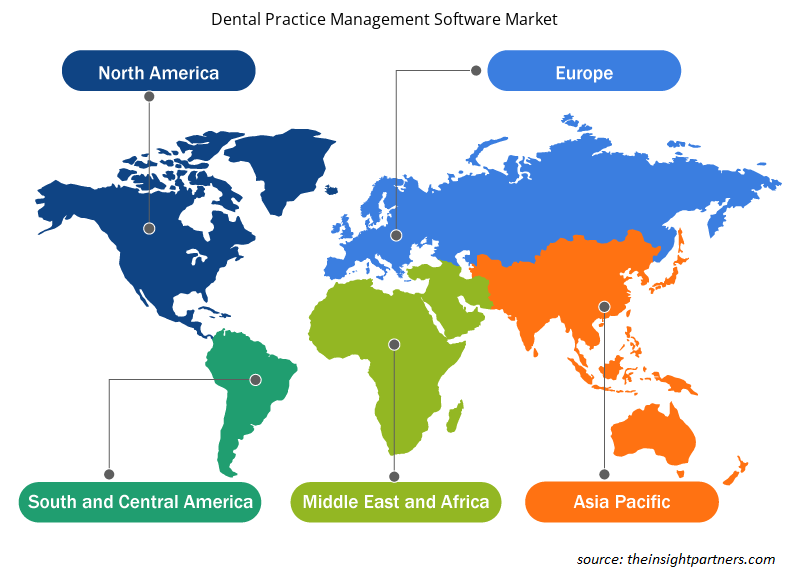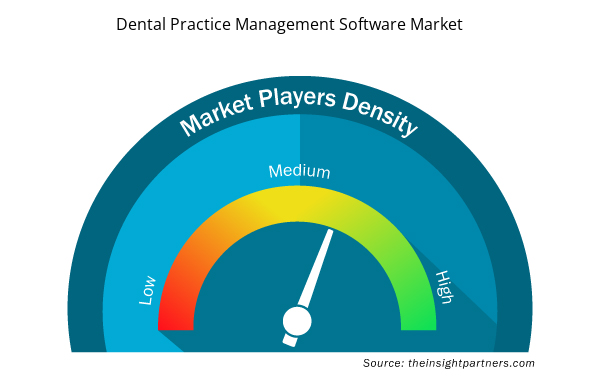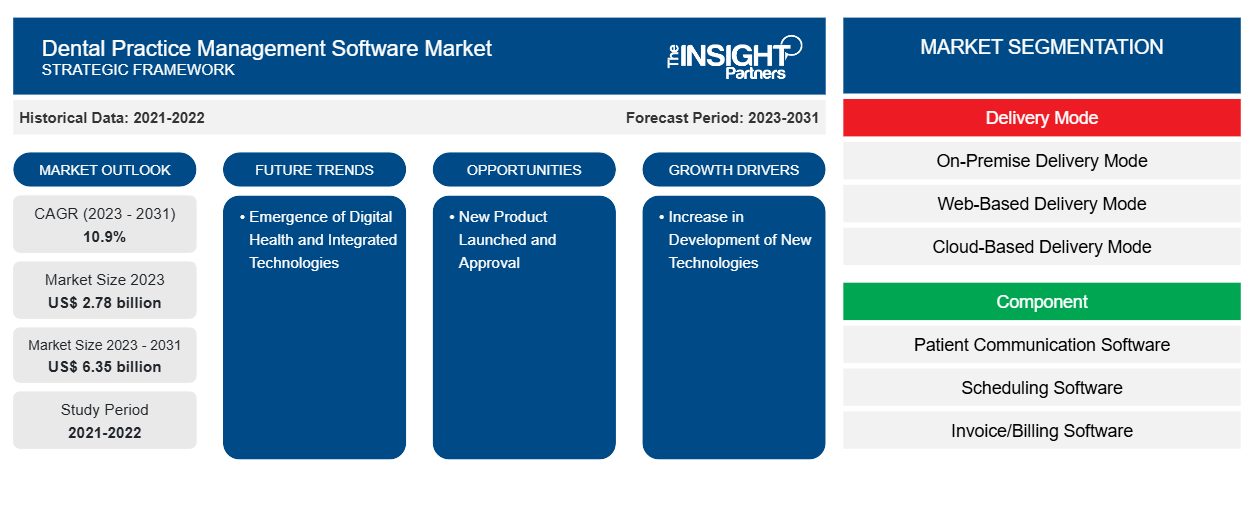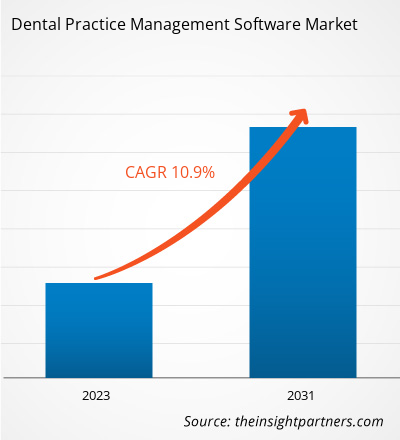2023 年牙科诊所管理软件市场价值为 27.8 亿美元,预计到 2031 年将达到 63.5 亿美元。预计 2023-2031 年市场复合年增长率为 10.9%。数字健康和集成技术的出现可能仍是牙科诊所管理软件市场的一个关键趋势。
牙科诊所管理软件市场分析
牙科诊所管理软件用于帮助牙医应对独特的挑战。这些解决方案是易于操作的基于云的软件,有助于简化临床和行政程序,并提供强大的工具来管理牙科诊所数据。牙科诊所管理软件为牙科诊所提供模板,可以导入和组织牙齿、X 光片和牙龈图形。这导致牙科医生越来越多地使用这种软件,从而推动了对牙科诊所管理软件的需求。
牙科诊所管理软件市场概览
全球大多数患者因意外、牙周病、受伤、蛀牙等原因而面临牙齿脱落。龋齿和牙周病的患病率不断上升且具有复发性,这增加了对牙髓治疗程序的需求。例如,蛀牙和牙周病是牙齿健康的两大主要风险。根据疾病控制和预防中心的数据,30 岁以上的成年人患牙周病的比率为 47.2%。牙周病的患病率随着年龄的增长而增加;在 65 岁及以上的成年人中,70.1% 患有这种疾病。男性比女性更容易患上这种疾病(56.4% vs. 38.4%)。因此,牙科疾病的高患病率可能会在未来几年推动牙医采用牙科诊所管理软件。
定制此报告以满足您的需求
您可以免费定制任何报告,包括本报告的部分内容、国家级分析、Excel 数据包,以及为初创企业和大学提供优惠和折扣
- 获取此报告的关键市场趋势。这个免费样品将包括数据分析,从市场趋势到估计和预测。
牙科诊所管理软件市场驱动因素和机遇
加大新技术开发力度 利好市场
牙科手术过程中收集的数据可以使用一种更安全、更标准化的信息系统进行管理,这种系统称为基于云的交付模式。借助基于云的系统,用户可以通过互联网或网络浏览器连接到计算机,随时在任何设备上访问数据。借助基于云的交付模式,商业和学术机构可以更轻松地管理从样品测试、仪器使用、自动化和报告生成等任务中生成的实验室数据。基于云的交付模式系统是一种非常可控的替代方案,它有助于访问医疗机构内有关患者、员工和设备的实时数据。芬兰牙科公司 Entteri 提供的 Romexis AssisDent 就是基于云的交付方法的一个例子。Romexis AssisDent 最大限度地提高了诊所的产出。它涵盖了患者体验的每个阶段,包括预约和提醒患者跟进。它还提供了用于业务报告的复杂工具。流程自动化为患者提供了各种管理解决方案。
新产品发布和批准——牙科诊所管理软件市场的机遇
由于全球人口数量庞大,需求不断增长,医疗保健行业正在持续快速发展,新产品开发、产品发布和审批也随之增加。此外,主要市场参与者正在投资研发活动,以确保高效产品的创新和开发。例如,2022 年 9 月,Carestream Dental 推出了一款新的基于云的口腔颌面外科实践管理软件解决方案。根据 Carestream 的新闻稿,该解决方案名为 Sensei Cloud for Oral Surgery,旨在为口腔颌面外科 (OMS) 专家提供可访问、用户友好的管理解决方案。2024 年 1 月,Smilefy, Inc. 发布了 Smilefy 4.0,这是一款由人工智能驱动的 3D 微笑设计程序。牙医可以创建可打印的 3D 模型,设计 3D 微笑,并让患者在承诺之前试用以查看他们的新微笑。这建立了现实的期望并促进了沟通。
牙科诊所管理软件市场报告细分分析
对牙科诊所管理软件市场分析做出贡献的关键部分是交付模式和组件。
- 根据交付模式,牙科诊所管理软件市场分为本地交付模式、基于 Web 的交付模式和基于云的交付模式。基于 Web 的交付模式部分在 2023 年占据了更大的市场份额。
- 按组件划分,市场分为患者通信软件、调度软件、保险管理软件、发票/账单软件和其他组件。调度软件部分在 2023 年占据了最大的市场份额。
牙科诊所管理软件市场份额(按地区)分析
牙科诊所管理软件市场报告的地理范围分为五个区域:北美、亚太地区、欧洲、中东和非洲以及南美/南美和中美洲。北美在 2023 年占据了市场的主要份额。美国牙科诊所管理软件市场正在增长,其次是加拿大。北美地区的医疗保健行业一直在见证牙科保健的快速转型。此外,牙科保健支出的增加可能会推动牙科诊所管理软件市场的增长。如果没有保险,美国典型的成年人整体牙齿健康状况良好(只有蛀牙等一些小问题),每年在牙科保健上花费 1,000 美元。美国每年在牙科保健上的花费约为 1300 亿美元,而且这一数字还在上升。美国人口老龄化、对美容牙科的兴趣日益浓厚以及牙科技术的发展是推动这一扩张的主要因素。
牙科诊所管理软件市场区域洞察
Insight Partners 的分析师已详细解释了预测期内影响牙科诊所管理软件市场的区域趋势和因素。本节还讨论了北美、欧洲、亚太地区、中东和非洲以及南美和中美洲的牙科诊所管理软件市场细分和地理位置。

- 获取牙科诊所管理软件市场的区域特定数据
牙科诊所管理软件市场报告范围
| 报告属性 | 细节 |
|---|---|
| 2023 年的市场规模 | 27.8亿美元 |
| 2031 年市场规模 | 63.5亿美元 |
| 全球复合年增长率(2023 - 2031) | 10.9% |
| 史料 | 2021-2022 |
| 预测期 | 2023-2031 |
| 涵盖的领域 | 按交付方式
|
| 覆盖地区和国家 | 北美
|
| 市场领导者和主要公司简介 |
|
牙科诊所管理软件市场参与者密度:了解其对业务动态的影响
牙科诊所管理软件市场正在快速增长,这得益于最终用户需求的不断增长,这些需求源于消费者偏好的不断变化、技术进步以及对产品优势的认识不断提高等因素。随着需求的增加,企业正在扩大其产品范围,进行创新以满足消费者的需求,并利用新兴趋势,从而进一步推动市场增长。
市场参与者密度是指在特定市场或行业内运营的企业或公司的分布情况。它表明在给定市场空间中,相对于其规模或总市场价值,有多少竞争对手(市场参与者)存在。
在牙科诊所管理软件市场运营的主要公司有:
- Carestream Dental 有限责任公司
- Curve Dental 有限公司
- 达塔康牙科系统
- Epic 系统公司
- 牙尖科技
- 亨利·沙因公司
免责声明:上面列出的公司没有按照任何特定顺序排列。

- 获取牙科诊所管理软件市场顶级关键参与者概览
牙科诊所管理软件市场新闻和最新发展
牙科诊所管理软件市场通过收集主要和次要研究后的定性和定量数据进行评估,其中包括重要的公司出版物、协会数据和数据库。以下是牙科诊所管理软件和策略市场发展列表:
- 领先的云端牙科软件提供商 Planet DDS 今天宣布,它已从专注于软件和技术支持业务的投资公司 Accel-KKR 手中完成了对 Cloud 9 Software 的收购。收购 Cloud 9 使 Planet DDS 能够继续其作为多专业牙科软件平台的强劲增长之路,同时增加 Cloud 9 在正畸和儿科实践管理软件方面的优势和经验。(来源:Planet DDS 公司名称,新闻稿,2023 年)
- 123Dentist、Altima Dental 和 Lapointe Group 已达成合并协议,将创建加拿大最大的牙科支持组织之一,支持近 350 家牙科诊所。此次交易的融资来自 123Dentist 现有金融合作伙伴 Peloton Capital Management 提供的股权资本;新投资者 KKR(一家领先的全球投资公司)和 Heartland Dental(KKR 投资组合公司和美国领先的牙科支持组织);以及 Altima Dental 现有金融合作伙伴 Sentinel Capital Partners。(来源:123Dentist 公司名称,新闻稿,2022 年)
牙科诊所管理软件市场报告范围和交付成果
“牙科诊所管理软件市场规模和预测(2021-2031)”报告对市场进行了详细分析,涵盖以下领域:
- 范围内涵盖的所有主要细分市场的全球、区域和国家层面的市场规模和预测
- 市场动态,如驱动因素、限制因素和关键机遇
- 未来主要趋势
- 详细的 PEST/波特五力分析和 SWOT 分析
- 全球和区域市场分析涵盖关键市场趋势、主要参与者、法规和最新市场发展
- 行业格局和竞争分析,涵盖市场集中度、热点图分析、知名参与者和最新发展
- 详细的公司简介
- 历史分析(2 年)、基准年、预测(7 年)及复合年增长率
- PEST 和 SWOT 分析
- 市场规模价值/数量 - 全球、区域、国家
- 行业和竞争格局
- Excel 数据集


- Data Annotation Tools Market
- Customer Care BPO Market
- 3D Mapping and Modelling Market
- Biopharmaceutical Contract Manufacturing Market
- Excimer & Femtosecond Ophthalmic Lasers Market
- Enzymatic DNA Synthesis Market
- Sodium Bicarbonate Market
- Integrated Platform Management System Market
- Europe Tortilla Market
- Third Party Logistics Market

Report Coverage
Revenue forecast, Company Analysis, Industry landscape, Growth factors, and Trends

Segment Covered
This text is related
to segments covered.

Regional Scope
North America, Europe, Asia Pacific, Middle East & Africa, South & Central America

Country Scope
This text is related
to country scope.
Trends and growth analysis reports related to Technology, Media and Telecommunications : READ MORE..
The Insight Partners performs research in 4 major stages: Data Collection & Secondary Research, Primary Research, Data Analysis and Data Triangulation & Final Review.
- Data Collection and Secondary Research:
As a market research and consulting firm operating from a decade, we have published and advised several client across the globe. First step for any study will start with an assessment of currently available data and insights from existing reports. Further, historical and current market information is collected from Investor Presentations, Annual Reports, SEC Filings, etc., and other information related to company’s performance and market positioning are gathered from Paid Databases (Factiva, Hoovers, and Reuters) and various other publications available in public domain.
Several associations trade associates, technical forums, institutes, societies and organization are accessed to gain technical as well as market related insights through their publications such as research papers, blogs and press releases related to the studies are referred to get cues about the market. Further, white papers, journals, magazines, and other news articles published in last 3 years are scrutinized and analyzed to understand the current market trends.
- Primary Research:
The primarily interview analysis comprise of data obtained from industry participants interview and answers to survey questions gathered by in-house primary team.
For primary research, interviews are conducted with industry experts/CEOs/Marketing Managers/VPs/Subject Matter Experts from both demand and supply side to get a 360-degree view of the market. The primary team conducts several interviews based on the complexity of the markets to understand the various market trends and dynamics which makes research more credible and precise.
A typical research interview fulfils the following functions:
- Provides first-hand information on the market size, market trends, growth trends, competitive landscape, and outlook
- Validates and strengthens in-house secondary research findings
- Develops the analysis team’s expertise and market understanding
Primary research involves email interactions and telephone interviews for each market, category, segment, and sub-segment across geographies. The participants who typically take part in such a process include, but are not limited to:
- Industry participants: VPs, business development managers, market intelligence managers and national sales managers
- Outside experts: Valuation experts, research analysts and key opinion leaders specializing in the electronics and semiconductor industry.
Below is the breakup of our primary respondents by company, designation, and region:

Once we receive the confirmation from primary research sources or primary respondents, we finalize the base year market estimation and forecast the data as per the macroeconomic and microeconomic factors assessed during data collection.
- Data Analysis:
Once data is validated through both secondary as well as primary respondents, we finalize the market estimations by hypothesis formulation and factor analysis at regional and country level.
- Macro-Economic Factor Analysis:
We analyse macroeconomic indicators such the gross domestic product (GDP), increase in the demand for goods and services across industries, technological advancement, regional economic growth, governmental policies, the influence of COVID-19, PEST analysis, and other aspects. This analysis aids in setting benchmarks for various nations/regions and approximating market splits. Additionally, the general trend of the aforementioned components aid in determining the market's development possibilities.
- Country Level Data:
Various factors that are especially aligned to the country are taken into account to determine the market size for a certain area and country, including the presence of vendors, such as headquarters and offices, the country's GDP, demand patterns, and industry growth. To comprehend the market dynamics for the nation, a number of growth variables, inhibitors, application areas, and current market trends are researched. The aforementioned elements aid in determining the country's overall market's growth potential.
- Company Profile:
The “Table of Contents” is formulated by listing and analyzing more than 25 - 30 companies operating in the market ecosystem across geographies. However, we profile only 10 companies as a standard practice in our syndicate reports. These 10 companies comprise leading, emerging, and regional players. Nonetheless, our analysis is not restricted to the 10 listed companies, we also analyze other companies present in the market to develop a holistic view and understand the prevailing trends. The “Company Profiles” section in the report covers key facts, business description, products & services, financial information, SWOT analysis, and key developments. The financial information presented is extracted from the annual reports and official documents of the publicly listed companies. Upon collecting the information for the sections of respective companies, we verify them via various primary sources and then compile the data in respective company profiles. The company level information helps us in deriving the base number as well as in forecasting the market size.
- Developing Base Number:
Aggregation of sales statistics (2020-2022) and macro-economic factor, and other secondary and primary research insights are utilized to arrive at base number and related market shares for 2022. The data gaps are identified in this step and relevant market data is analyzed, collected from paid primary interviews or databases. On finalizing the base year market size, forecasts are developed on the basis of macro-economic, industry and market growth factors and company level analysis.
- Data Triangulation and Final Review:
The market findings and base year market size calculations are validated from supply as well as demand side. Demand side validations are based on macro-economic factor analysis and benchmarks for respective regions and countries. In case of supply side validations, revenues of major companies are estimated (in case not available) based on industry benchmark, approximate number of employees, product portfolio, and primary interviews revenues are gathered. Further revenue from target product/service segment is assessed to avoid overshooting of market statistics. In case of heavy deviations between supply and demand side values, all thes steps are repeated to achieve synchronization.
We follow an iterative model, wherein we share our research findings with Subject Matter Experts (SME’s) and Key Opinion Leaders (KOLs) until consensus view of the market is not formulated – this model negates any drastic deviation in the opinions of experts. Only validated and universally acceptable research findings are quoted in our reports.
We have important check points that we use to validate our research findings – which we call – data triangulation, where we validate the information, we generate from secondary sources with primary interviews and then we re-validate with our internal data bases and Subject matter experts. This comprehensive model enables us to deliver high quality, reliable data in shortest possible time.


 获取此报告的免费样本
获取此报告的免费样本